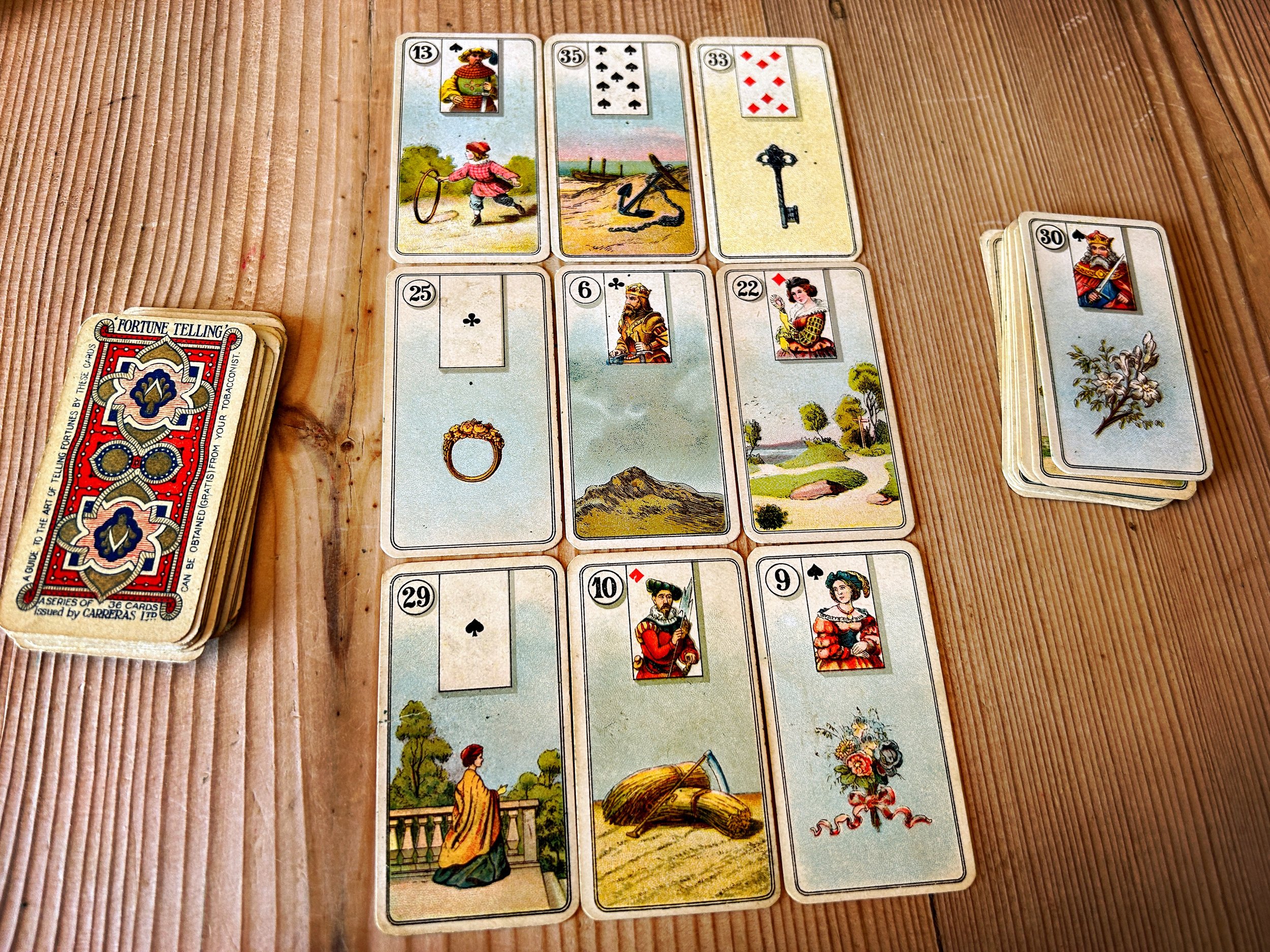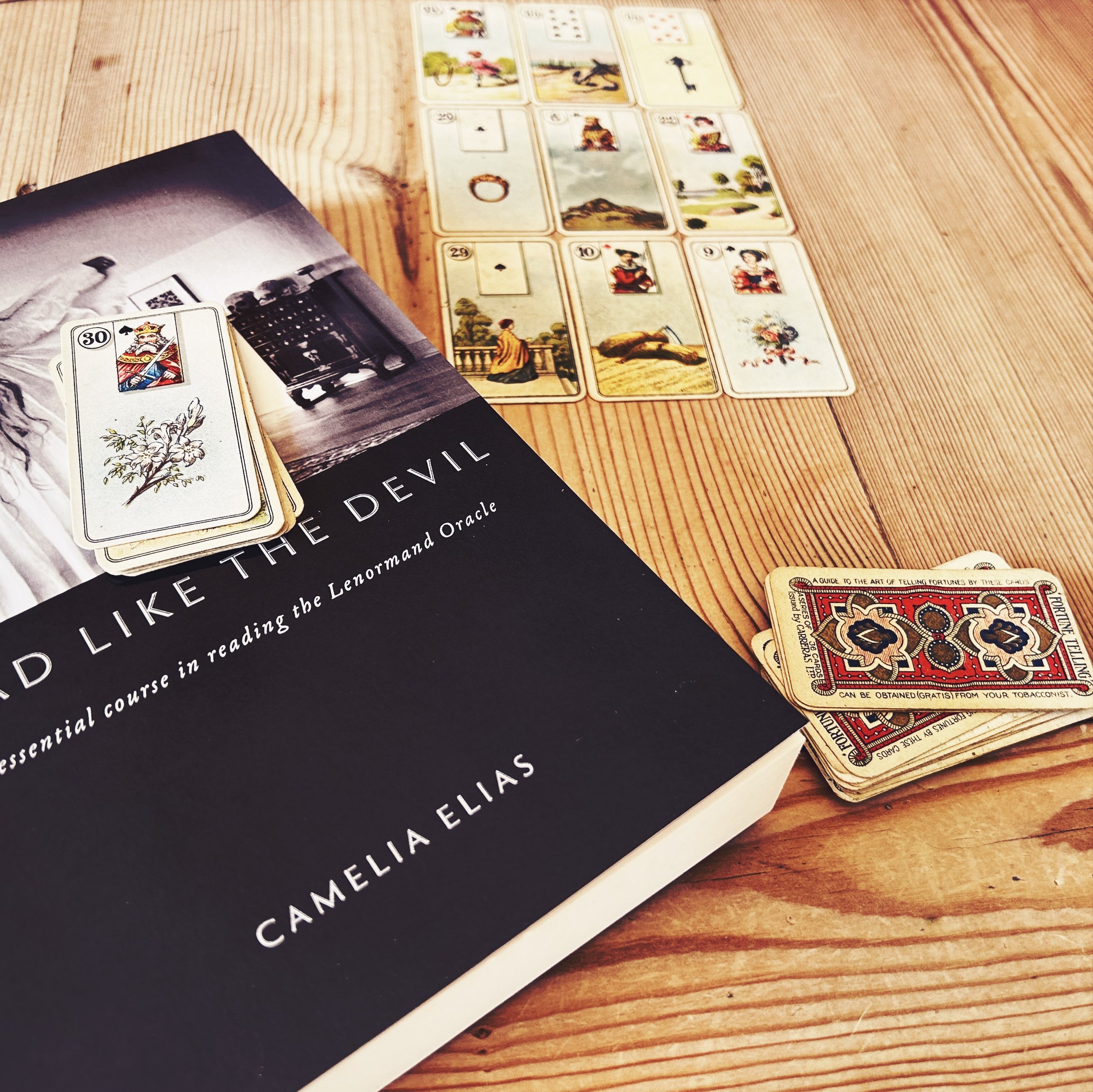The game of perception
‘What you cultivate, you harvest,’ I told a woman once, in response to her concern with making an impact on a certain man of power. ‘But there are others,’ she said, and it was my turn to say, ‘so what?’ It was clear to me from the cards that what she was dreaming of was happening. If her aim was to make an impact, the cards on my table said that this was the case. Let’s see how.
Just by looking at the first column of cards featuring the Child, the Ring, and the Woman was enough for me to pass this judgment: whatever game the woman was playing, it had lasting consequence. Why? Because visually the Ring was twice in the picture. Once as itself alongside with the Ace of Clubs, and once in the Child’s play with the Jack of Spades presiding. ‘This was the ring of infinity,’ I thought, whereupon I proceeded to unpack what I was seeing.
‘You’re the magister ludi, the master of the game,’ I said to the woman, and pointed to how her play landed a cherished ring on her finger. This was, however, not a ring that the man she wanted to impress gave her, as he was in the fog about how to go about it, the Ring, that is. He was the King of Clubs with a clouded judgment regarding both what the woman was doing and how he could respond to it. So the Ring was not in the picture as a representation of concrete bond between the Woman and the king of Clubs. Rather, this was a Ring of contemplation in the perception of both parties.
Visually the Ring is above the Woman, and thus on her head, and to the left of the man’s line of vision, suggesting that it was going in circles, as it were, yet as if also waiting to happen. The card above the Ring featuring a circle stressed this idea. As for the Clouds next to the Ring, we could say that this was a sign of veiling it, making us think that the Ring was both there and not there, both thought about and yet also dealt with in absconsus, or in secret.
Now, although the overall message here from the entire tableau is quite clear, if we stop to think about what was happening here, we realize that this idea of the veiled ring is the most exciting to consider, especially when we talk about impact. Let’s see how, by looking at the other cards.
To the left of the card of Clouds at the center of this tableau is the Crossroads, featuring the enterprising Queen of Diamonds as an alternative to the potential confusion that we might ascribe to the King of Clubs via the card he presides over, namely the Clouds. What is her function here? To point to which way to go? Judging by the position of the King of Clubs, we could argue that he is oblivious to this Queen’s opinion, so her impact, if she is there to make any, is minimal.
Similarly, we have another Queen in the picture, namely the Queen of Spades on the card of Flowers. What is her function here? The Flowers below the Crossroads, mirroring also the Key at the top, could make us formulate a hypothesis: either the clueless King of Clubs was being rewarded with a key that could unlock his possibilities, a key provided by what the querent, the Woman here, was cultivating at the level of the image of her solid play (Child, Anchor), or else, we’re here with the idea of the Queen of Spades winning the game, the suit of the Spades representing our woman, what with the Ace of Spades presiding on our sigificator card, namely the Woman.
I went with this latter notion, as crossing the tableau with an x enforced it too: regardless of the weather, the Child is determined to play (Child, Clouds, Flowers; with the Ace of Spades mirroring the Jack of Spades for the idea of determination). The Key to the Ring in the King of Club’s line of sight is the Woman, not some random Crossroads Queen smelling of money (Key, Clouds, Woman).
Also, the Scythe cuts both Flowers and Lilies. In the Woman’s hand, or in the hand of the young Jack of Diamonds – ready to do the Woman’s bidding – the Scythe can be a tool towards the ultimate sublime. The card of the Lily in the wings, as the surprise card here, suggests purity and cultivated beauty.
I started out by saying that what the woman cultivated, she would harvest. This message stayed to the point of identifying just was was cultivated here, namely the Woman’s game that consolidated her relationship with the man she wanted to enchant with her mastery, a skill that promised to open all the roads unto the beauty of flowers.
In addition to the iconic images here, we could argue that the suit of Spades ruled the game. What was initiated through the rolling of the ring, ended up with the embodiment of the Woman in the Queen of Spades, the consort of the King of Spades looking on. The last card met the surprise card in union.
It is for this reason that I offered my remark, ‘so what?’ in response to the Woman’s concern with the other women in ‘her’ King’s life. Even in his cloudy state, the King’s eyes are on the Ring as a representation of his desire to bond with the Woman, rather than getting lost at the Crossroads, and thus subjecting himself to the influence of dictations coming from other self-interested parties.
I told the woman that while she was still able to exert an impact, she also participated in the veiling of her aim – not her game, but her aim – the consequence being ‘the others.’ And yet, perhaps this veiling act was what rendered her as the forever more fascinating Woman in the eyes of the King, making ‘the others’ lose the game, if they entered it as third parties or second choices, for, at the end of the day, no one can win the duel with the master of swords and scythes.
♠
Cards: Dondorf Fortunetelling Cards, issued by Carreras, a tobacco company that made them for collecting with the purchase of the Black Cat pack of cigarettes in 1926.
*
The Lenormand big book
Just about every aspect of reading cards with the Lenormand Oracle has been covered in the third volume of the Read Like the Devil trilogy, a book that features many examples of 9-card squares.


